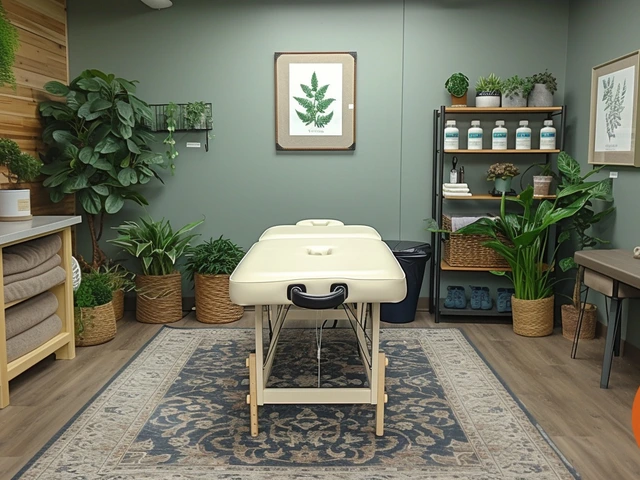
Unraveling the Mysteries of Myofascial Release Therapy
Imagine being seized by a hard-to-define pain that refuses to let go, like a shaggy dog holding onto its favourite chew toy. In my case, Toffee's favourite toy is an old football boot, but talking about my beagle's shenanigans is a story for another day. Now back to the persistent, nagging discomfort that just won’t budge, no matter how many painkillers you throw at it. Welcome to the world of chronic pain sufferers and let me introduce you to a remedy known as myofascial release therapy.
You are probably wondering, 'What's myo-thing-a-ma-jig?' Well, myofascial release therapy – let’s call it MRT – is a type of physical therapy that targets the connective tissue (fascia) encasing your muscles. The therapy aims to alleviate tension and inflammation, promote blood flow, and foster mobility, getting you up and running like a well-oiled machine–or a playful beagle, in Toffee's case.
Truth be told, when I first encountered the term, I thought it was some alien technology out of a sci-fi movie. Little did I realise at the time how this non-invasive, natural treatment would transform my life, taking the sting out of a lingering back injury turned chronic pain.
A Deep Dive Into the World of Fascia
Fascia, in the simplest terms, is the biological fabric that holds us together. It's like the white, fibrous layer you find when peeling an orange or the silvery membrane cocooning a chicken breast. It’s mostly made up of collagen, enveloping muscles, organs, nerves–pretty much everything in your body. As it’s so widespread, it’s easy to envision how things can go south when the fascia tightens or gets injured, leaving you in a world of pain.
Before my foray into MRT, I was oblivious of fascia’s existence, let alone its vital role. It was only when I started grappling with the aftermath of a sports-related back injury that the concept was thrust into my pain-addled consciousness. Who knew that just bending over wrong while playing a round of golf would give me an unwelcome and extended membership in the chronic pain club?
The Mechanism of Myofascial Release Therapy
The crux of MRT lies in the application of gentle, sustained pressure on the myofascial connective tissue. Think of it as a very intense massage where the therapist uses their knuckles, elbows, or tools to knead out the kinks from your body. It delves deeper than a normal massage, targeting the labyrinthine layers of fascia. The aim is to break down the physical and, dare I say, emotional barriers that have manifested in your body as chronic pain or mobility restrictions.
MRT worked for me like a charm–with that iron-knuckled magic, my therapist went right after the heart of the beast, my pain. The good news is it’s not all Thor's hammer and Hercules' strength. This isn’t a one-size-fits-all technique, it’s tailored according to the individual’s specific pain-inducing areas, ability to withstand pressure and overall health. No need to feel like a character out of a Greek tragedy!
The Far Reaching Benefits of Myofascial Release Therapy
You wouldn't think applying pressure could have so many positive outcomes, would you? But here's the reality, MRT not only targets pain relief but also tackles other health-related ailments. It's been found to improve posture, boost range of motion, and enhance sleep quality. Remember, pain has a knack for shooting your stress levels through the roof, which can lead to poor sleep. However, providing relief from the pain severs this torturous cycle, allowing you to achieve sleep as undisturbed as Toffee’s, who looks like she's meditating when she's snoozing.
Science backs this up too! A study published in the Journal of Bodywork and Movement Therapies found significant improvements in pain severity and health-related quality of life among participants who underwent myofascial release therapy. Now, isn't that a strong argument to consider MRT for chronic pain management?
My Personal Journey with Myofascial Release Therapy
Every tale has its hero, and in my story of chronic pain, MRT wears the hero's cape. The path to relief began when my physiotherapist suggested MRT after traditional methods weren't making a dent in my tenacious back pain. Admittedly, the first few sessions felt like I was wrestling with a rhinoceros, but once the initial discomfort wore off, the difference was stark. The unbearable pain that was once part and parcel of my everyday existence began to subside. And let's just say, each progressive session made me value the phrase "no pain, no gain" even more!
Embarking on this therapeutic journey was nothing short of transformational. Today, I can bend down to pick up Toffee’s wayward toys without fearing an impending back spasm. I've even managed to see a decrease in the number of painkillers I consume. Cracking the chronic pain code felt like unlocking a new level of existence, a life where the shadow of agony doesn’t loom so large.
Incorporating Myofascial Release Techniques into Everyday Life
Fun and interesting fact: you don't always need a qualified therapist to administer MRT. Sure, they possess that refined touch honed by years of training. However, there are self-myofascial release techniques you can incorporate into your routine–like rolling a tennis ball under your foot or using a foam roller to unknot the tension in your back. A bit like how Toffee performs a rather extravagant stretch every morning without fail, always prompting me to think, 'Shouldn't I be doing the same?'
Remember to research and learn these techniques properly and always exercise caution. Your fascia is as much a part of you as your heart or brain–mistreat it, and it will make you live to regret it. So always remember the golden rule: never push yourself to the point of excruciating pain.
A Future Free of Chronic Pain with Myofascial Release Therapy
If you’re battling chronic pain, then myofascial release therapy has a lot to offer. It’s like your friendly neighbourhood superhero, eager to save your day and bring you closer to a future free of chronic pain. Are you ready to usher in a fresher, vibrant, and hopefully pain-free chapter of your life?
Before signing off, here's a piece of wisdom from your friendly Bristol-born blogger – pain may be part of life, but living through endless, relentless pain doesn’t have to be. With awareness, the right approach, guidance, and a little perseverance, you too can overcome your pain, just like I did. And on that hopeful note, just as Toffee snores gently at the foot of my desk, it's time for me to step away from the keyboard and prepare another unexpected journey that life has to offer.




